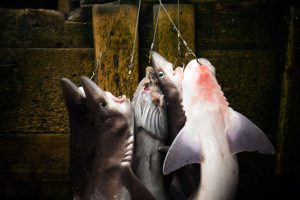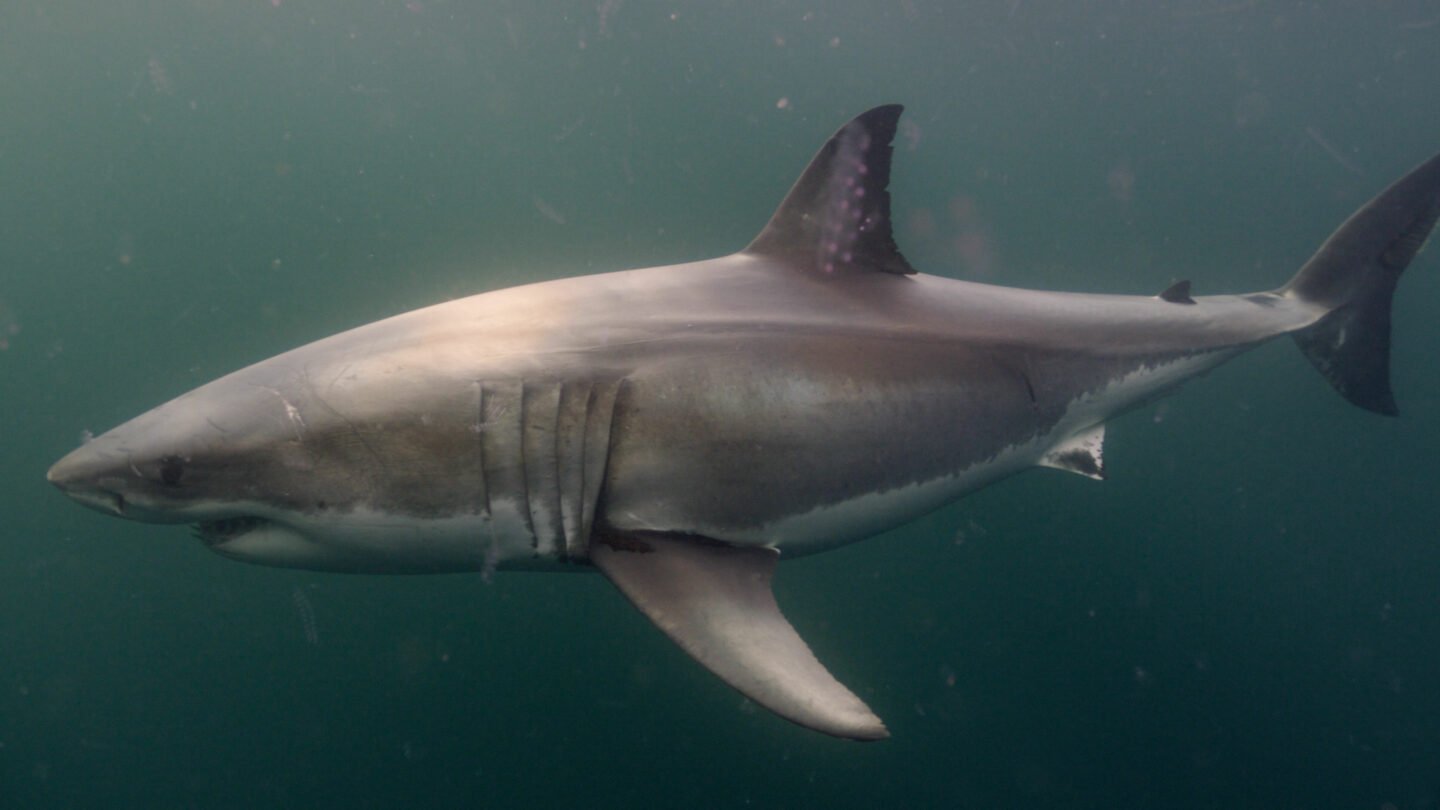
Wildlife
The great green shark hunt
Can British Columbia’s spiny dogfish make the grade as the world’s first “sustainable” shark fishery?
- 3319 words
- 14 minutes
Wildlife
Korean-Canadian filmmaker Sonya Lee dives deep into the world of great white sharks for the latest documentary from CBC’s The Nature of Things

Known for their power, speed and strength, great white sharks are one of the most elusive fish in the sea — and easily one of the most feared. Equipped with razor-sharp teeth, streamlined bodies and strong crescent-shaped tails, these apex predators could be something out of a nightmare, but in reality, “your chances of being crushed by a vending machine are higher than being bitten by a shark,” says Korean-Canadian filmmaker Sonya Lee.
Great white sharks have been roaming our oceans for millions of years, keeping food chains in check, ecosystems healthy and oceans thriving. But recently, an increasing number of Canadians have spotted this iconic fish in Atlantic Canada, sparking curiosity, awe and fear, leaving many people wondering: why do these sightings keep happening — and what do they mean?

In an effort to answer these questions, a team of self-professed “shark nerds,” including a dive instructor, science educator, citizen scientist and wildlife filmmaker, came together to create Jawsome: Canada’s Great White Sharks, the newest documentary from CBC’s The Nature of Things.
Produced by Vancouver-based River Road Films, the same production company behind the 2023 Emmy-Award-winning Island of the Sea Wolves, Jawsome explores what’s happening with great white sharks in Atlantic Canada — and the connection humans have with this elusive species.
Director, co-writer and co-producer Sonya Lee spoke with Canadian Geographic about what went into the making of this documentary and what she hopes viewers will take away from the film.
I was living in Halifax at the time. There is a Halifax Instagram community page called halifax noise (@hfxnoise). I started seeing a lot of people’s posts of seeing great white sharks from the beach or from their boat, and I just thought it was really interesting to read the comments section because it ranged from, “Oh my god, this is so cool,” to, “Oh my god, this is terrifying, I am never going in the water” to: “Oh, it’s not a big deal, they’ve always been here.”
It was really interesting from a storytelling perspective, but then I was like, “We can never film them.” So, I kind of put it aside. Then my friend, who’s a wildlife filmmaker, Nick Hawkins, who’s also a Canadian Geographic photographer and a Nat Geo Explorer sent me a video of him filming sharks. He went out and tried it, and he’s like, “I think we can do this.” And I was like, “Oh my god, I think we can.”

One of the reasons is because there’s a big grey seal population off the coast of Nova Scotia. It’s the largest grey seal colony in the world, so it’s an abundant food source for white sharks.
Researchers are still looking into it, but they also think that it’s probably a bit of observer bias, which is because people have more phones, they are being tracked by satellite tags, and there’s a public website where you can track these sharks. It’s more accessible to see them, so there might not be an actual increase in numbers.
Heather Bowlby at the DFO, who is the scientist we worked with as our expert lead, said that sharks have a really long lifespan, and they were starting to get protected 50 to 60 years ago, and they might just be seeing the fruits of that conservation effort. So she was saying that it’s really exciting to see more of them, but there’s a lot more research that needs to be done in terms of numbers.
It means that it’s very healthy. Supporting a large apex predator like a white shark means there needs to be abundant food resources. That comes with the grey seals, and it’s actually really exciting that there’s a predator because there’s been a huge boom in the [seal] population. There’s a lot of controversy around whether or not they’re affecting the fisheries and other parts of the ecosystem lower down the trophic level. So, having a large predator like a white shark keeping that population in check is very exciting.

Firstly, it was extremely challenging to film them. I guess we went in thinking that if we put a food source in the water near places where you know there are white sharks, they are going to come to the boat, and that was not the case. There were so many factors that went into having the right conditions for filming, and we just had terrible weather that year. It was very windy, and we had multiple big hurricanes come through. Hurricane Fiona hit the year we were filming. So, it was very challenging in that way.
The most interesting thing I learned was that I really wanted to focus on people’s relationship with sharks and not sensationalize and give the “large, scary human-eating machine” kind of characteristics to a shark. I really wanted to go into the different ways that we can interpret a shark’s behaviour. They are very cautious, they are very curious. They come in and “boop” the bait with their fins or their nose before doing anything.
There are so many different kinds of relationships people have had with sharks over thousands of years in Nova Scotia and on the East Coast, and [we were] able to delve more into that and show that people have always had a relationship here. This is not new, and these are some of the ways that we can exist together with sharks.

I had the privilege of getting a family story from Melissa and Todd Labrador, who are Mi’kmaw
from Acadia First Nation, and they are traditional birch bark canoe builders. They shared a story about how their ancestors went out really offshore in their canoes. They were porpoise hunting, and they had great white shark interactions. That family story didn’t make it into the film. But what did make it into the film was that the Mi’kmaq had a traditional way to deter sharks, which is to put spruce roots on their canoes with other more near-shore vegetation like eel grass and other seaweed to make it feel like it’s in the shallows and not in the deep.
We also worked with Dr. Matthew Betts at the Canadian Museum of History, and he has been working with Mi’kmaq and other Indigenous communities on the East Coast, looking at their mittens and he’s been finding great white shark teeth. With radiocarbon dating, they’ve dated it back to over 4,000 years, so there has been a relationship between white sharks with Indigenous Peoples on this coast for over 4,000 years. And it stops abruptly at the time of colonization.
The thing that everyone goes to is Jaws. And although it was an awesome film, I don’t think it gave white sharks a good reputation or sharks, for that matter, a good reputation. They were portrayed as just human-killing machines, and that’s really not the case. But I think the other thing, especially with white sharks, is that they’re so elusive, and they are really hard to study. Even scientists still have a hard time understanding what white sharks do and where they go because they’re such long migratory species, and they are solitary, so they are really hard to study. But, for the most part, they are very cautious and curious and we can definitely exist with them without being in danger.

I think the first thing is to acknowledge that you’re in white shark territory when you’re going into the ocean, but you can be shark-smart about it. If there are any seals around, I wouldn’t be in the water because if there are seals, that’s shark food. Also, a lot of white sharks hunt at dawn and dusk, so if you are swimming by yourself and looking like a seal at dawn or dusk… you can avoid those times.
And the chances of you getting bitten by a shark are less than a vending machine falling on you. The chances are very, very low. And if you really think about the risks and statistics, you are more in danger of crossing the road or driving your car than getting eaten by a shark. Just keep those in mind and be mindful and respectful. If you feel like you’re in a not-so-great situation, then just get out of the water.
I purposefully didn’t have scientists as main characters in the film because I wanted to [be a] role model and exemplify that if you are curious about something, you, as a non-scientist, can find out those answers and learn more and be curious. You don’t have to be a scientist to do research or learn more about the ocean.
People have relationships with sharks, and they are positive. And also [the fact] that there are sharks in Canada is so cool, and we should be so proud and so stoked to have these amazing creatures in Canadian waters. There are not a lot of places in the world where you can see them, and the fact that we have them here is so special.
I would love to see more research on white sharks in Canada. They are so hard to study, but [it would be great] to figure out what they are doing in Canada and how we can protect them. The more we know, the more we can help to protect this species. Because they are so long-lived, anything that we do now is going to take 50 to 60 years to see fruition. So, more protection, more studies and also more people just understanding that you can still go in the water. You can still enjoy the ocean. You just have to be shark-safe and share the space with sharks.
Jawsome: Canada’s Great White Sharks will premiere on Thursday, Jan. 25, on CBC Gem and CBC TV at 9 p.m. (EST).
Are you passionate about Canadian geography?
You can support Canadian Geographic in 3 ways:

Wildlife
Can British Columbia’s spiny dogfish make the grade as the world’s first “sustainable” shark fishery?

Wildlife
Dr. Chris Harvey-Clark shares his experience coming face-to-face with one of the ocean’s top predators while scuba diving near Halifax, N.S.

Wildlife
Encountering the carcass of one of the ocean’s top predators and how studying its remains can help researchers save the living

Wildlife
An estimated annual $175-billion business, the illegal trade in wildlife is the world’s fourth-largest criminal enterprise. It stands to radically alter the animal kingdom.